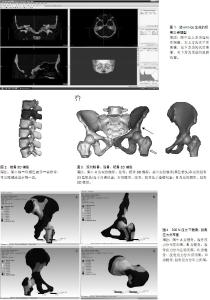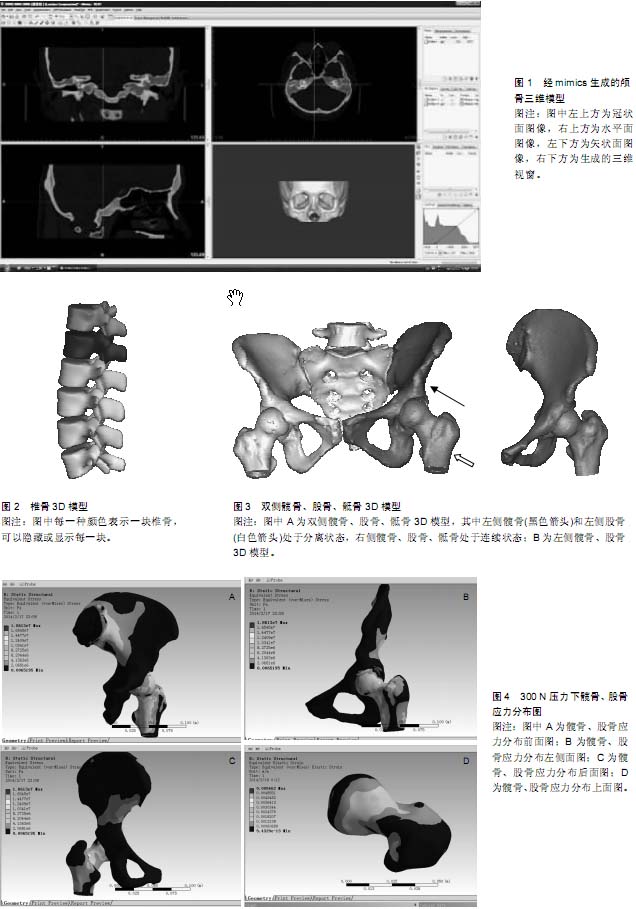| [1] 杨玲,阮心玲.模型导向的矩形建筑物三维重建[J]. 计算机工程与应用,2014,39(4):83-87.
[2] Schwarz F, Sculean A, Georg T, et al. Periodontal treatment with an Er: YAG laser compared to scaling and root planing. A controlled clinical study. J Periodontol. 2001;72(3):361-367.
[3] 孙宇.颈椎人工椎间盘置换术可以减少相邻节段退变和相邻节段疾病[J].中国脊柱脊髓杂志,2011,21(1):3-4.
[4] 陈玉琴,钱海馨.牙列重度磨耗患者的咬颌重建修复治疗[J].上海交通大学学报(医学版),2011,31(8):1216-1218.
[5] 刘亚雄,李涤尘,卢秉恒,等.快速原型在口腔颌面修复中的应用(2)--下颌骨替代物的个体化制造[J]. 实用口腔医学杂志,2003, 19(5):408-409.
[6] 崔治.基于医学CT图像的三维重建研究[D].长春:吉林大学.2006.
[7] 李运锋,刘修国.基于方向包围盒投影转换的轮廓线拼接算法[J].计算机应用,2011,31(12):3353-3356.
[8] 冷大炜,马洪兵,孙卫东.基于2D-3D泛轮廓点对应的三维刚体目标的迭代姿态估计[J].中国科学院研究生院学报,2012,29(6): 821-828.
[9] 贺健康,李涤尘,卢秉恒,等.定制化胫骨平台系统的构建及应用[J].中国生物医学工程学报,2007,26(1):134-137.
[10] 王旭,马昕,陶凯,等.足踝有限元模型的建立与初步临床应用[J].中国生物医学工程学报,2008,27(2):287-292.
[11] 王剑利,潘朝晖,袁勇,等.足骨三维有限元模型对足跖骨缺损重建的指导意义[J].实用手外科杂志,2007,21(1):6-8.
[12] 杨文峰,俞光荣,牛文鑫,等.人体足主要骨-韧带结构三维有限元模型的建立及分析[J].中国运动医学杂志,2007,26(5):542-546.
[13] 王卉,吴涛.Mimics三维重建模型在人体解剖学学习中的应用[J].中国医学教育技术,2012,26(6):664-667.
[14] 蔡伟斌,胡鸿璇,郭新辉,等.锁定加压钢板与解剖钢板置入内固定治疗复杂胫骨平台骨折[J].中国组织工程研究,2012,16(52): 9750-9755.
[15] BIBA. http://www. biba. uni-Bremen. de.
[16] 肖博,刘祥谋,马海,等. STL文件快速分层及填充算法研究[J].机械与电子,2012(12):20-23.
[17] 王运赣.快速成形技术[M].武汉:华中理工大学出版社,1999: 29-31.
[18] 闫涛.基于高斯曲率的三角网格模型简化的研究[J].计算机工程与科学,2012,34(12):126-129.
[19] 陈友军,何洪英,潘大志.基于向量的多边形扫描转换方法[J].智能计算机与应用,2012,2(5):81-83.
[20] 马洁.一种基于线性代数的图像处理算法研究[J].计算机科学, 2012,39(11):286-288.
[21] 乔庆昆.三维STL模型的快速成型关键技术研究[J].微型机与应用,2011,30(3):6-8.
[22] 石教英,蔡文立.科学计算可视化算法与系统[M].北京:科学技术出版社,1996:106-192.
[23] 刘磊.计算机图像处理技术在医学影像学上的应用[J].中国老年学杂志,2012,32(24):5642-5643.[24] Lee TY, Lin PH, Lin CH, et al. Interactive 3-D virtual colonoscopy system. IEEE Trans Inf Technol Biomed. 1999; 3(2):139-150.
[25] 梁荣华,吴云飞,马祥音.局部特征加强的体绘制算法[J].计算机辅助设计与图形学学报,2012,24(10):1301-1309.
[26] Boissonnat JD. Shape reconstruction from planar cross sections. Comput Vis Graph Image Process. 1988;44(1):1-29.
[27] Wongpakdee PK. Resurfacing graphics. J Arts Humanit. 2014; 8(3):9-18.
[28] Douros L, Dekker L, Buxton BF. Reconstruction of the surface of the human body from 3D scanner data using B-splines Patches. Proc SPIE. 1999;3640:234-245.
[29] 王瑞娟,张季,彭可.计算机辅助医学图像三维重建的算法分析[J].中国组织工程研究与临床康复,2011,15(4):745-748.
[30] Rajon DA, Bolch WE. Marching cube algorithm: review and trilinear interpolation adaptation for image-based dosimetric models. Comput Med Imaging Graph. 2003;27(5):411-435.
[31] 熊平,杨呁.基于等值面点的快速三维表面重建算法[J].微计算机信息,2010,26(14):6-7.
[32] 陈兵,蒙培生.基于Dividing Cubes的算法实现螺旋CT数据的三维重建[J].计算机应用研究,2003,20(4):63-64.
[33] 李金,胡战利.基于Marching Cubes与Ray Casting的医学图像三维重建[J].生命科学仪器,2007,5(12):40-43.
[34] Zhong L, Li L, Sun JH, et al. Preoperative diagnosis of gastric cancer using 2-D magnetic resonance imaging with 3-D reconstruction techniques. Chin J Dig Dis. 2005;6(4):159-164.
[35] 刘硕明,陆敏,陈军.医学图像融合技术浅谈[J].黑龙江科技信息,2012 (36):1-2.
[36] 徐超,张晓东,许源,等.骨科医学断层图像的三维重构应用及其纹理特征研究[J].解剖学研究.2012,34(5):364-369.
[37] 钟务学,张银网,朱海波,等.采用体绘制方法建立人股骨三维有限元模型及其应力分析[J].中国组织工程研究,2012,16(17): 3048-3051.
[38] Drebin RA, Carpenter L, Hanrahan P. Volume rendering//Computer Uraphics Proceedings, Annual Conference Series, ACM SIGGRAPH. New York: ACM Press, 1988:65-74.
[39] Drago F, Myszkowski K, Annen T, et al. Adaptive logarithmic mapping for displaying high contrast scenes. Comput Graph Forum. 2003;22(3):419-426.
[40] Yuan X, Nguyen MX, Chen B, et al. HDR VolVis: high dynamic range volume visualization. IEEE Trans Vis Comput Graph. 2006;12(4):433-445.
[41] 刘兵全,何继善,李振伟,等.医学图像后处理研究进展[J].国外医学(生物医学工程分册),2013,27(4):248-252.
[42] 高玉喜.基于生物特征的图像数字水印算法[J].中国外资(下半月),2012(12):363-364.
[43] Kruger J, Westermann R. Acceleration techniques for GPU-based volume rendering//IEEE Visualization, Seattle, Washington, USA, 2003:287-292.
[44] 管伟光.体视化技术及其应用[M].北京:电子工业出版社,1998: 71-72.
[45] Diaz J, Vazquez PP. Depth-enhanced maximum intensity projection//Proceedings of the 8th IEEE/Eurographics International Symposium on Volume Graphics. Airela-Ville Eurographics Association Press. 2010:93-100.
[46] Lorensen WE, Cline HE. Marching cubes: a high resolution 3D surface construction algorithm. Comput Graph. 1987; 21(3):163-169.
[47] 张元科,张军英,卢虹冰. 低剂量CT投影图像噪声分析及去噪算法研究[J].光电子.激光,2010,21(7):1076-1077.
[48] 舒翔,曾文,汪刘一,等.基于逆向工程重构沙发三维模型的研究[J].制造业自动化.2011,33(8):117-119.
[49] 束搏,邱显杰,王兆其.基于图像的几何建模技术综述[J].计算机研究与发展,2010,47(3):551-552.
[50] 陈德生,王美凤.X线在踝关节韧带损伤中的临床价值和应用[J].中国社区医师(医学专业),2011,13(1):119-120.
[51] Mei-Dan O, Kots E, Barchilon V, et al. A dynamic ultrasound examination for the diagnosis of ankle syndesmotic injury in professional athletes: a preliminary study. Am J Sports Med. 2009;37(5):1009-1016.
[52] Takao M, Innami K, Matsushita T, et al. Arthroscopic and magnetic resonance image appearance and reconstruction of the anterior talofibular ligament in cases of apparent functional ankle instability. Am J Sports Med. 2008;36(8): 1542-1547.
[53] Polliack AA, Sieh RC, Craig DD, et al. Scientific validation of two commercial pressure sensor systems for prosthetic socket fit. Prosthet Orthot Int. 2000;24(1):63-73.
[54] Wang XS, Duan YX. The hip stress level analysis for human routine activities. Biomed Eng (Singapore). 2005,17(3): 153-158.
[55] Koenig SJ, Toth AP, Bosco JA. Stress fractures and stress reactions of the diaphyseal femur in collegiate athletes: an analysis of 25 cases. Am J Orthop (Belle Mead NJ). 2008; 37(9):476-480.
[56] Wang XS, Jiang FC, Duan YX. The stress level analysis for dynamic cases at human hip joint, The 29th International Society of Biomechanics and 29th America Society of Biomechanics Congress. Cleveland, USA, 2005.
[57] Sekkati H, Mitiche A. Joint optical flow estimation, segmentation, and 3D interpretation with level sets. Comput Vis Image Underst. 2006;103(2):89-100.
[58] Knoche W. Limb prosthesis of the 19th and 20th century. Vasa. 2009;38 Suppl 74:75-83.
[59] 郑卫国,颜永年,周赫赫,等.快速成形技术在临床外科手术中的潜在应用[J].清华大学学报,2002,42(8):1038-1041.
[60] Vetkoff DJ, Herr RD, Doss BL. A High-speed 3D image for inspection and measurement of miniature industrial parts. SME Vision Proceedings, Chicago, 1989. |

